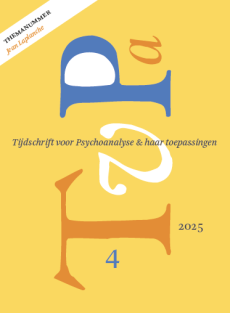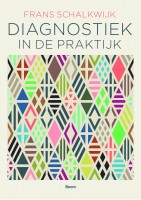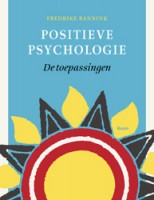De irrationele dimensie van de psychoanalyse
Summary
The irrational dimension of psychoanalysis
A major reason for the resistance against psychoanalysis is the fact that this discipline has a fundamentally irrational dimension. Two dimensions may be discerned in Bion’s work on psychic processing of perceptions, feelings and thoughts: transformation in Knowledge and transformation in O. This paper elaborates how Bion places the irrational dimension of psychic functioning and of psychoanalysis to the fore when developing his ideas on the transformation in O. This is discussed in the context of other approaches and illustrated with a clinical vignette.
Literatuur
- BARGH, J.A. & MORSELLA, E. (2009). Unconscious behavioral guidance systems. In C. Agnew, D. Carlston, W. Graziano, & J. Kelly (red.) (2009). Then a miracle occurs — Focusing on behavior in social psychological theory and research (p. 89-111). New York: Oxford University Press.
- BATEMAN, A. & FONAGY, P. (2004). Psychotherapy for borderline personality disorder. Oxford: Oxford University Press.
- BION, W.R. (1962). A theory of thinking. In W.R. Bion, Second thoughts, (p. 110-119) New York: Jason Aronson, 1967.
- BION, W.R. (1965). Transformations. Londen: Karnac, 1984.
- BION, W.R. (1970). Attention and interpretation. Londen: Karnac, 1986.
- BION, W.R. (1991). A memoir of the future. Londen: Karnac.
- BION, W.R. (1992). Cogitations. Londen: Karnac.
- DAMASIO, A. (2000). The feeling of what happens. Londen: William Heineman.
- FONAGY, P. (2008). A genuinely developmental theory of sexual enjoyment and its implications for psychoanalytic technique. Journal of the American Psychoanalytic Association, 56, 11-36.
- EIGEN, M. (1981). The area of faith in Winnicott, Lacan and Bion, International Journal of Psycho-Analysis, 62, 413-433.
- FREUD, S. (1911). Formuleringen over de twee principes van het psychisch gebeuren. Werken 5 (p. 332-339). Amsterdam: Boom.
- FREUD, S. (1915). Het onbewuste. Werken 7 (p. 65-102). Amsterdam: Boom.
- GROTSTEIN, J.S. (2007). A beam of intense darkness — Wilfred Bion’s legacy to psychoanalysis. Londen: Karnac.
- KANDEL, E.R. (1999). Biology and the future of psychoanalysis — A new intellectual framework for psychiatry revised. American Journal of Psychiatry, 156, 505-524.
- MAAT, S. DE, DEKKER, J., SCHOEVERS, R. & JONGHE, F. DE (2007). The effectiveness of longterm psychotherapy — Methodological research issues. Psychotherapy Research, 17, 59-65.
- MATTE-BLANCO, I. (1988). Thinking, feeling and being. Londen/New York: Routledge/Institute of Psycho-Analysis.
- SANDELL, R., BLOMBERG, J., LAZAR, A., CARLSSON, J., BROBERG, J. & RAND, H. (2000). Varieties of long-term outcome among patients in psychoanalysis and long-term psychotherapy — A review of findings in the Stockholm outcome of psychoanalysis and psychotherapy project (STOPP). International Journal of Psychoanalysis, 81, 921-943.
- SHEDLER, J. (2010). The efficacy of psychodynamic psychotherapy. American Psychologist (ter perse).
- VERMOTE, R. (2011). Reading Bion — A chronological exploration of Bions writings. In D. Birksted-Breen (red.), The New Library of Psychoanalysis Teaching Series. Londen: Routledge (ter redactie).
- VERMOTE, R., FONAGY, P., VERTOMMEN, H., VERHAEST, Y., STROOBANTS, R., VANDENEEDE, B., CORVELEYN, J., LOWYCK, B., LUYTEN, P. & PEUSKENS, J. (2009). Outcome and outcome trajectories of personality disordered patients during and after a psychoanalytic hospitalisation-based treatment. Journal of Personality Disorders, 23, 294307.
 © 2009-2025 Uitgeverij Boom Amsterdam
© 2009-2025 Uitgeverij Boom Amsterdam
ISSN 1382-516x
De artikelen uit de (online)tijdschriften van Uitgeverij Boom zijn auteursrechtelijk beschermd. U kunt er natuurlijk uit citeren (voorzien van een bronvermelding) maar voor reproductie in welke vorm dan ook moet toestemming aan de uitgever worden gevraagd:
Behoudens de in of krachtens de Auteurswet van 1912 gestelde uitzonderingen mag niets uit deze uitgave worden verveelvoudigd, opgeslagen in een geautomatiseerd gegevensbestand, of openbaar gemaakt, in enige vorm of op enige wijze, hetzij elektronisch, mechanisch door fotokopieën, opnamen of enig andere manier, zonder voorafgaande schriftelijke toestemming van de uitgever.
Voor zover het maken van kopieën uit deze uitgave is toegestaan op grond van artikelen 16h t/m 16m Auteurswet 1912 jo. Besluit van 27 november 2002, Stb 575, dient men de daarvoor wettelijk verschuldigde vergoeding te voldoen aan de Stichting Reprorecht te Hoofddorp (postbus 3060, 2130 KB, www.reprorecht.nl) of contact op te nemen met de uitgever voor het treffen van een rechtstreekse regeling in de zin van art. 16l, vijfde lid, Auteurswet 1912.
Voor het overnemen van gedeelte(n) uit deze uitgave in bloemlezingen, readers en andere compilatiewerken (artikel 16, Auteurswet 1912) kan men zich wenden tot de Stichting PRO (Stichting Publicatie- en Reproductierechten, postbus 3060, 2130 KB Hoofddorp, www.cedar.nl/pro).
No part of this book may be reproduced in any way whatsoever without the written permission of the publisher.
Nieuwsbrief Boom Psychologie
Meld u nu aan en ontvang maandelijks de Boom Psychologie nieuwsbrief met aantrekkelijke aanbiedingen en de nieuwe uitgaven.
Aanmelden


